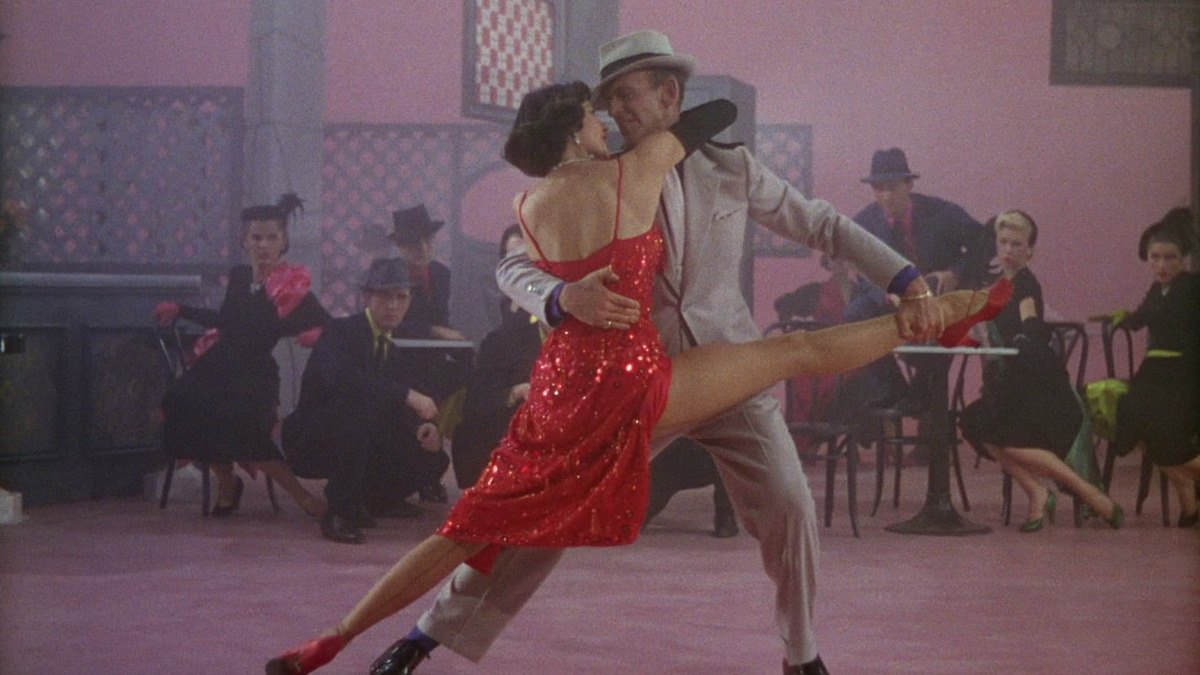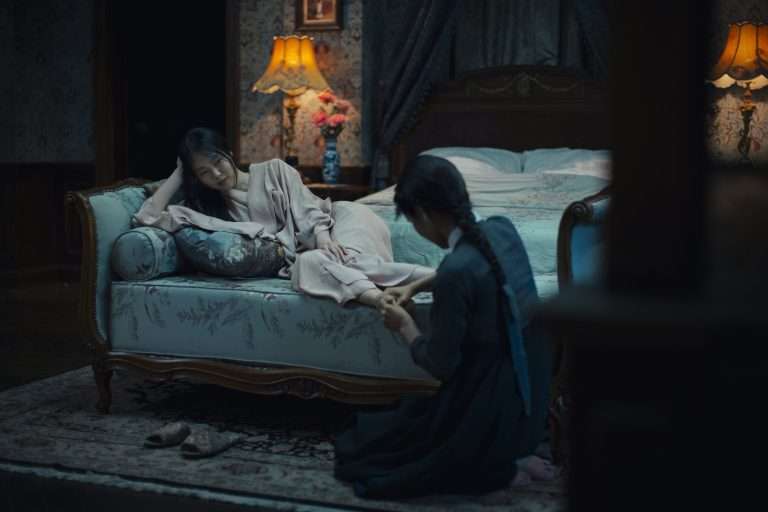When you think of the Hollywood Musical, three images are likely to conjure up in your mind: seeing young Dorothy Gale, just after landing in Oz, open the door for an overwhelming explosion of Technicolor marvel; Gene Kelly singing and dancing in the rain, the image of him clinging onto that streetlight forever ingrained into our cinematic minds; and, of course, the image of a young Fred Astaire wearing his iconic top hat and tails. It’s that last image that’s on our minds whenever we see an older Fred Astaire dance and sing in Vincente Minnelli’s “The Band Wagon” (1953).
That someone well into their 50s was still able to move, to dance, to sing, and to perform at this kind of caliber? To watch Fred Astaire move was like watching an artist perfect a brushstroke, to watch Fred Astaire dance was learning how to commit murder (and maybe even get away with it, too), and to watch Fred Astaire, late into his movie career, still prove why he’s one of the most foundational performers ever is both beautiful and melancholic.
Sure, Astaire made other films after “The Band Wagon,” but none of them are fascinated with deconstructing the image of Fred Astaire. Leave it to Vincente Minnelli, the inarguable champion of the Hollywood Musical, to take note of Astaire’s impact on the cinematic language and create a film that masks itself as a ridiculous comedy about a Broadway show off the rails (and the behind-the-scenes banter that ensues).
But in reality, it’s one of the defining films about so many different things: the changing landscape of art, creating art as a means to express the seemingly inexpressible, the fading image of art’s changing landscapes (watching people disappear into the past, destined for the textbooks), and have this all be explored through Fred Astaire’s own experience. “The Band Wagon” is a remarkable film, an overwhelmingly beautiful piece of filmmaking, but it’s also a staggering work in which Minnelli and Astaire lay it all out on the line and hold nothing back.
Much of what “The Band Wagon” focuses on is the evolution of art and entertainment. The film ponders whether the two ideas can even be married together: is something truly entertaining if it’s also meant to stir some thought-provoking thoughts or intense emotional responses, or is art forever destined to be viewed as a “pretentious” (a dirty, dirty word) examination without being entertaining? Minnelli wants to unearth the answers to this in perhaps the most bombastic way possible: the Musical.
When you think of Musicals, you may think of the flair, the spectacle, the lavish landscapes, and the incredible production. You’ll think of words like “fluidity” and “motion” and “movement” and believe that things are possible – that dreams can be our reality if we desire them, long for them, need them. But “The Band Wagon,” in comparison to Minnelli’s other Musicals, isn’t like this: it’s a work that dials itself back, stripping the foundations of the Musical to its rawest conception. We can almost see the bones.
Two playwrights meet their friend, Tony Hunter, at a train station with exciting news: they’ve written a new show and they want Tony, a fading star of Musicals on stage and screen, to star in their show. And they even get the best director around, but once he’s gotten hold of what the project is, he completely rejects it and chooses to take the playwrights’ words to create a stage adaptation of Faust. Because, to the director, there has to be a visceral response to your art; there has to be something that affects us when we consume it.
Cinema and shows, music and paintings – people cannot examine and absorb them without the possibility of something justifying its existence, a blatant slap to say “Hey, I understand why I’m watching this.” And once the show gets underway and chaos ensues, it’s evident that the director’s ambition is destroying the foundation of what art can be. Art can be both meaningful and entertaining; there doesn’t always have to be an overt reaction to make something meaningful, and art doesn’t always have to be conventionally “entertaining” for it to be just that. Minnelli is ruminating on these two ideas because there must be an answer: there must be a marriage.

Minnelli chooses to linger on the images that we often associate with our art: the bodies. Tony is roped into this mess and quietly witnesses the project implode. More so, he clashes heavily with a ballerina, Gaby Gerard, in that they’re really unable to understand (or speak to) each other. The communication between the two is terrible: they’re two figures from two opposite and fading art forms, forced to work together with the hope that they’ll make it look good on the stage despite their feistiness towards each other.
What brings them together is an unspoken bond in what their art form means to them: acknowledging that it means so much to people who come to see them and knowing that doing it is the only thing they can do in their lives, because without it, they would be empty and meaningless. Why do artists create? “The Band Wagon” suggests that artists create art because they have to create: it’s a form of expression that helps establish themselves during times where they can’t even speak – and yes, even the ones trying to create “reactionary” art are applied to this theory, too.
We understand this in perhaps the film’s most beautiful – and I really mean beautiful – moment: the “Dancing in the Dark” sequence. In that three sequence, we see two people, who don’t completely understand each other in the slightest, realize that the ways they’ve attempted to communicate have been lackluster. Watching them dance quietly against the Central Park backdrop, now that’s where the language between the two becomes apparent: the movement of the bodies as they dance and twirl and contort themselves.
There’s quiet professionalism on their faces, but deep down, we know they’re pouring their hearts out to each other with the hope that this will ease the tensions between them – and the beautiful thing is that it does. Art is for the masses – we, as the audience, have been given a gift in consuming art that can impact us and change us – but we also need to realize that those creating the art are just like us, too. They’re finding a language in which they can communicate. Even Cordova, who realizes his language merely culminates in a disingenuous conclusion, deserves that expression.
There’s a sequence in “The Band Wagon” that’s not left my brain. It’s the scene where Fred Astaire’s Tony stumbles onto what 42nd Street has become: mindless games and money-grabbing machines are on every corner, and people are eating them up. After playing around for a minute, Tony begins to dance and sing, and the crowd of people focused on the games slowly turns their heads to him. They’re laughing, smiling, completely excited to see someone like Tony doing the things that he’s doing. The power in watching someone doing something extraordinary, instead of wasting your money on meaningless contraptions, is so much more valuable and impactful – inspiration and beauty.
Minnelli is commenting, rather humorously, on how people’s ideas of entertainment have changed, but that once they’re witnessing something truly overwhelming, they’re likely to find themselves more attracted to that. A man dancing, showing off his skill, is more likely to cause shock and awe rather than a hall of mirrors that distorts the image: watch the living and breathing image in our own reality, and not one manipulated by cheap tricks and goofy ideas.
Recommended: 10 Essential Movies About Theater and Theater Artists
Ultimately, everything that Minnelli is doing in “The Band Wagon” is connected to Fred Astaire. This is a film about Fred Astaire without directly saying it’s about Fred Astaire: we can just see it through the dynamics between the characters, the reactions, the dances, and Astaire’s own performance, a performance with so much quiet vulnerability and melancholy, unlike any of his other performances. Without Astaire, the effectiveness of “The Band Wagon” would buckle and crumble.
Through dialing the elements of the genre back, Minnelli has allowed Astaire’s own personal flourish to consume the film and make it his. The fading star of the past in a landscape that’s trying to push him out, the desire to continue making art, and finding that he may be a relic, despite the excitement that people show when they see him perform. Astaire, at this point, was nearing the end of his film career and would only star in a handful of films. “The Band Wagon” is the man’s last burst of pure excitement and craft, helmed by a filmmaker who understands his significance.
This is an Astaire who knows he’s looking at the inevitable. Art, like many things, is something meant to evolve and change, and with that, people’s connections and understandings with it change, too. Astaire’s art form will quietly fade into near-irrelevance – despite the attempts by Hugh Jackman, there’s hardly anyone today who’s remotely close to Fred Astaire – and with this in mind, this makes “The Band Wagon” all the more beautiful and sadder.
A man coming to terms with his bond to art, with how people receive it, with the shifting world around him, and with the knowledge that even as he himself fades into the past, he will endure on celluloid and in textbooks—a testament to how Fred Astaire’s artistry made an indelible impact and continues to move those who encounter it.
Astaire uses this film to come to terms with so many things in his life, and through Minnelli’s direction, we have one of the greatest works of art ever made: a film about art, the artist, and Astaire. Even in its saddest parts, to know he entertained so many is enough for him to give us that signature smile and dance off into the sunset for one last beautiful time. He may have made more films after this, but “The Band Wagon” is the only film concerned with exploring Astaire’s own image and legacy.
Astaire has gone on record saying that he never wants a biopic made about him. Of course, Tom Holland and Hollywood are attempting to disrespect his wishes by making something that will surely be the most basic Oscar-bait nonsense ever made. But after seeing this, it’s even clearer that a Biopic about the man shouldn’t exist – Minnelli and Astaire already made it while he was alive.


![Get Out [2017]: Stay Woke OR Sink To The Floor](https://79468c92.delivery.rocketcdn.me/wp-content/uploads/2017/05/get-out-768x432.jpg)

![Cold Pursuit [2019] Review: Revenge Served Lukewarm](https://79468c92.delivery.rocketcdn.me/wp-content/uploads/2019/02/Cold-Pursuit2-768x433.jpg)

![Song To Song [2017]: The Fleeting Feeling Of Love](https://79468c92.delivery.rocketcdn.me/wp-content/uploads/2017/06/SONGTOSONG-768x333.jpg)
